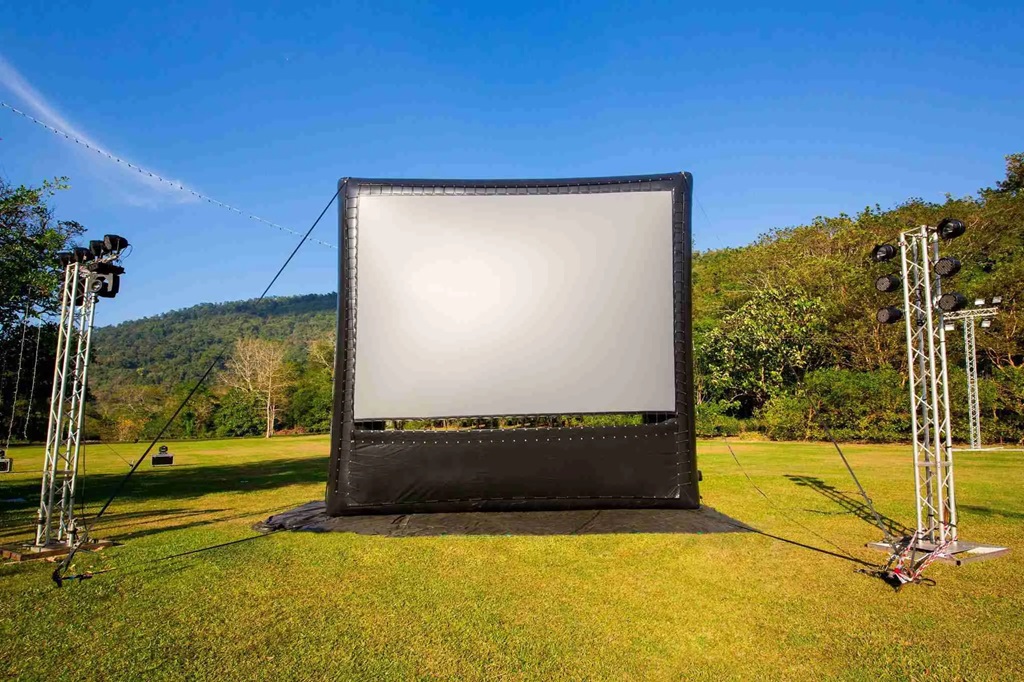A blow up projector screen is an excellent way to enjoy large-screen entertainment without the constraints of a physical theater. These portable screens are convenient to set up and offer an immersive viewing experience for both indoor and outdoor settings. Here is a comprehensive guide on how to set up and use an inflatable projector screen. It covers everything you need to know to make the most of this equipment.
Choosing the Right Blow Up Screen
Blow up projector screens come in a variety of sizes, materials, and prices. Here are the key factors to consider when selecting one:
Size
Inflatable screens range in size from about 50 inches up to massive 20 foot screens. Consider what size screen will work best for your intended use. Larger screens of 150 inches or more are great for outdoor movie nights where people will be seated further away. Smaller screens around 80-120 inches are ideal for indoor use where the audience will be closer.
Also factor in your projector’s throw distance – how far back it needs to be positioned to project a clear image at a given screen size. Refer to your projector manual for recommendations.
Aspect Ratio
Make sure to match your screen’s aspect ratio (width x height dimensions) to your projector. Most home projectors are 16:9 ratio, the standard widescreen format. Screens are available in 16:9, 16:10, and 4:3 ratios.
Material
Inflatable screens are made from durable PVC or polyester materials. Matte white screens provide the best image quality with wide viewing angles. Screens with a grey rear projection material work well for outdoor daytime use when ambient light is an issue.
Price
Blow up screens range in price from $50 on the low end to $500+ for larger professional screens. In general, you get what you pay for in terms of materials, construction quality, accessories, and ease of setup.
Portability
Consider the weight, pack up size, and ease of setup if you will be transporting your inflatable screen to different locations. Look for screens with a carrying case and compact folding design.
Setting Up a Blow Up Screen
Blow up projector screens are designed for quick, easy setup. Here is the basic process:
1. Find a Flat Surface
Identify a suitable location that has a flat, level surface. This is essential for keeping the screen taut and preventing distortion. Hard surfaces like concrete work best, while softer or uneven ground can cause sagging issues.
2. Spread out and Anchor the Base
Lay out the heavy base material that comes with your inflatable screen. For outdoor use, you’ll need to anchor down the edges with stakes and ropes to prevent the base from shifting in the wind. Indoors, you can usually rely on the weight of the base.
3. Attach the Blower Fan
Find the blower fan and sleeves that fit into the screen’s valves. Carefully attach the fan to inflate the screen. Make sure all connections are secure.
4. Inflate the Screen
Turn on the fan to inflate the screen. It should only take 1-2 minutes to fully inflate. The base will flatten out as the screen takes shape above it. Make sure there are no gaps, tears or sagging areas.
5. Position your Projector
Place your projector the recommended throw distance from the screen to project a focused image sized to fill the screen. Consult your owner’s manual for specifics.
6. Level and Tension the Screen
There are usually adjustable straps on the corners of the base that allow you to level the screen and add tension if needed. Tighten these by hand to get a flat, taut viewing surface.
Using and Maintaining an Inflatable Screen
Here are some tips for getting the best results from your blow up screen and keeping it in good shape:
Position Carefully
Avoid positioning the screen where people may trip over the base or cables. Also check for any overhead obstructions that could cast shadows when projector is on.
Watch the Wind
Outdoors, position the screen so prevailing winds hit the back rather than front which can distort the image. Consider adding side panels for very windy conditions.
Clean the Surface
Use a soft cloth to gently wipe the screen surface if needed to remove dust or dirt. Never use harsh chemicals which could damage the material.
Store Properly
Allow the screen to fully deflate, fold up according to the manufacturer instructions, and place back in the carrying case after each use. Avoid creases or folds during storage and transport.
Check for Leaks
Periodically inspect the screen for small holes or leaks, especially if you notice it losing air pressure. Leak detectors or soapy water can help identify any seams or weak points that need patched.
Replace Blower Fan
The blower fan motors have a lifespan of about 500 hours in most cases. Replace this component if needed to maintain adequate airflow.
Troubleshooting Issues
Here are some common problems and solutions for inflatable projector screens:
Screen Won’t Inflate Fully
- Make sure blower fan is properly attached and turned on to full power.
- Check for leaks and patch with included repair kit if needed.
- If leaks are not the issue, the fan motor may need replaced.
Image Not Focused
- Adjust projector distance and zoom settings to get a focused image edge to edge.
- Make sure screen is fully inflated and flat with no sagging areas.
Distorted or Stretched Image
- Level out screen base and tighten corner straps to remove any distortions.
- Make sure screen fabric is not flapping in wind – add side panels if needed.
Creases and Wrinkles in Screen
- Inflate screen fully before use to remove wrinkles and stretch it out.
- Ensure screen is not folded or creased during setup, storage, and transport.
- Gently stretch across affected areas of screen with your hands if needed.
Dim Image Outdoors
- Use a grey screen material designed to reduce washout in daylight.
- Position screen to minimize ambient light shining on surface.
- Use a high lumen projector designed for outdoor viewing.
Accessories and Enhancements
There are several handy accessories you can utilize to get the most out of your inflatable projector screen:
Screen Anchors and Tie Downs
Stakes, ropes, sandbags, or water barrels placed around the perimeter help secure the screen in windy outdoor conditions.
Side Panels
Black side panels that attach to the frame block ambient light from the sides and improve contrast.
Rear Projection
A translucent rear projection screen allows you to position the projector behind the screen.
Tripod Screen Support
A tripod stand in the middle helps stabilize large blow up screens and prevent sagging.
Fastening Systems
Zippers, velcro, stakes, or pole pockets make it easy to attach and remove accessories.
Protective Storage Cases
Padded cases with wheels simplify transport and provide protection during storage and travel.
Spare Blower Fan
Having a backup blower motor ensures the show goes on if your main fan fails.
Ideal Uses
Thanks to their oversized viewing, portability, and ease of setup, blow up projector screens are great for:
- Outdoor movie nights in backyards or parks
- Large screen gaming tournaments and esports events
- Presentations, conferences, graduations, and other special events
- Promotional displays at festivals, fairs, or pop-up events
- Movies or sports viewing in community spaces like camps or recreation centers
- Private screenings in hotel rooms, meeting spaces, or temporary venues
With the right setup, positioning, and care, an inflatable projection screen delivers an immersive big screen experience anywhere you need it. They provide great bang for your buck compared to fixed-frame screens.
FAQs
What size blow up screen do I need?
This depends on your seating distance and projector. As a general guideline, opt for a 100-120” screen for viewer distances of 8-12 ft, 150” screen for 12-18 ft, and massive 20 ft screens when seating is 18 ft or more away.
How long do blow up projector screens last?
With proper care and storage, an inflatable screen can last 3-5 years or longer. Avoiding creases, replacing the blower fan as needed, and patching leaks helps extend the lifespan.
Do you need special projectors for inflatable screens?
Any projector can be used, but opt for at least 2000 lumens for smaller screens and 4000+ lumens for larger outdoor screens to ensure sufficient brightness.
How do you get wrinkles out of the screen?
Gently stretch across wrinkled areas by hand once screen is fully inflated. Storing the screen properly deflated and flat also prevents wrinkles from developing.
What do I do if my screen gets a hole?
Use the patching kit included with most inflatable screens. Clean the area thoroughly, apply adhesive, layer patch over hole, press down firmly for 30 seconds until bonded.
Can you leave inflatable screens up permanently?
It’s not recommended. Constant inflation weakens the seams over time. Regular deflation and proper storage extends the life of your blow up screen.
Is an inflatable screen better than a fixed frame?
Inflatable screens offer bigger viewing sizes for lower cost, greater portability, and easier setup than fixed frames. But fixed frames have a more permanent, wrinkle-free surface.
Conclusion
Blow up projection screens offer big screen entertainment options wherever you need them. They are easy to set up and take down, extremely portable, and provide great viewing experiences on a budget. With sizes available up to 20 feet, inflatable screens are ideal for both indoor and outdoor use.
By choosing the right size and materials, setting up properly on a flat surface, and caring for your screen, an inflatable projector screen can provide years of service. Enhance your business presentations with a ceiling projector; with the right accessories, you can improve stability, contrast, and functionality, while blow-up screens make it possible to create an immersive cinematic or gaming experience both at home and on the go.
Tags: blow up projector screen, cinematic experience, DIY movie night, event planning, home theater tips, inflatable screen guide, outdoor entertainment, portable projection, projector screen setup, visual display tutorial





Leave a Reply